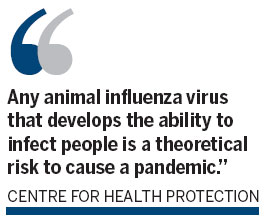Fearing the flu
Updated: 2014-01-10 06:48
By Kristine Yang(HK Edition)
|
|||||||
The flu season is upon us and every year anxiety among the community grows with new and scarier versions of the virus appearing. While there are solid reasons to be vigilant, local health authorities say the current flu season is not as scary as it may at first have seemed. Kristine Yang writes.
Less than two weeks ago, a particular strain of avian influenza claimed its first victim in Hong Kong.
An 80-year-old man died in hospital on December 26. He had been admitted for chronic heart disease and diabetes but doctors found that he was infected with A(H9N2) influenza. The man had been living in Shenzhen, presumably became infected there.

In another case, health authorities caught the first ever case of avian influenza in Hong Kong involving the A(H7N9) strain. The patient was a 36-year-old Indonesian domestic helper who killed and cooked a chicken in Shenzhen.
Ripples of fear spread throughout the city after authorities isolated 17 other people who had been in contact with her. The Indonesian woman remained in hospital at the end of December, but stable and on her way to recovery. None of the other 17 people was infected.
A recent outbreak of avian influenza A virus on the mainland had killed 45 people by the end of December.
There has been no widespread outbreak linked to either of the strains that turned up in Hong Kong but the SAR remains under an influenza pandemic alert. Health authorities have raised the local alert level to "Serious Response Level" for about a month.
Despite the propensity of many in Hong Kong to break out the face-masks and hand sanitizers at the mere mention of influenza, the alert sounds more scary than it really is, even if authorities are being extra careful to err on the side of caution.
"(The Serious Response Level) defines a moderate risk of serious human infections caused by the novel influenza virus in Hong Kong, but serious infections are not expected to be widespread in the short term," says the Preparedness Plan for Influenza Pandemic of the Hong Kong government.
In other words, says Thomas Abraham, Director of the Public Health Media Program at the University of Hong Kong, the alert "means there are human infection cases. The response level is automatically upgraded and the risk is moderate."
Cases of human infection from other strains of influenza such as H5N1 and H9N2 had been detected in Hong Kong previously but the infection found in the Indonesian woman was the first linked to the H7N9 strain.
"We know all these viruses increase selectively in chickens during the winter months. We also know during the Chinese New Year, there are more chickens being produced and sold. So, for all those reasons, in these coming month or two, we are likely to create a threat from the avian influenza virus," said Professor Joseph Peiris from the School of Public Health of the University of Hong Kong.
"At the moment, the most concerning (strain) for Hong Kong is H7N9 virus. H5N1 is a greater (threat) in many countries, in Indonesia, Vietnam and Egypt but, for Hong Kong, it is not such a major problem. But as H7N9 is present on the Chinese mainland, it would be a concern for Hong Kong because people may travel to the mainland and may get infected and come back to Hong Kong to be diagnosed. Also the virus may come in via poultry."
This simple fact is behind the thinly veiled but ever present fear of an outbreak. There are thousands of people moving every day between Hong Kong and areas on the mainland where the virus is present.

"The real danger for Hong Kong would be people going to Shenzhen and contacting live poultry," said Abraham.
But even in the event of an outbreak, the impact would likely be limited. The virus is treatable in most people and the economy would not likely be as severely affected as it was during SARS.
Fear of chicken
"The only impact would be the demand for chicken during Chinese New Year would drop, which would be similar with last year," said Abraham.
SARS, on the other hand, had a significant impact on the city. Some 299 people died and the economy took a big hit - it took five years for property values to recover to pre-SARS levels.
From the beginning of 2003, the avian influenza A(H5N1) virus has infected 648 people and caused 384 deaths, but almost none have been in Hong Kong. The most affected area in the world is Indonesia, which had 195 human cases and 163 deaths. Egypt had 63 deaths and Vietnam 62 deaths, according to Hong Kong's Centre for Health Protection (CHP).
Bird flu pandemics emerged in East Asia in 2004 and 2005, while Hong Kong reported bird flu cases in 2008, 2011 and 2013.
Despite being increasingly common, avian strains are hardly the only type of influenza.
In the spring of 2009, influenza A(H1N1), known as human swine influenza, emerged and resulted in a pandemic with 34,174 cases reported around the world. Another 2,722 cases were reported in 2010.
According to the CHP, H1N1 has emerged as a seasonal influenza strain in Hong Kong.
"People can die from seasonal flu but it is more dangerous to the elderly and children," said Abraham.
"Seasonal flu itself is quite significant. It has killed thousands of people in Hong Kong every year but these are mainly people over 65. It is always there as a problem. Other viruses like H7N9 are more occasional problems," said Peiris.
On Jan 6, the CHP reported that an 18-year-old special school student with underlying medical conditions had died from influenza A virus. The school reportedly shut down for seven days, after six other students became infected.
The number of influenza virus detections reported jumped from 64 in the week to Dec 7 to 245 in the week ending Jan 4. In the first week of this year, the CHP reported that half the cases reported were influenza A(H3N2) and about 30 percent were influenza A(H1N1). About 19 percent of cases were influenza B.
Another virus that the CHP is tracking is the Middle East Respiratory Syndrome, which has not been detected in Hong Kong to date.

"No human infection with this virus has been identified so far in Hong Kong," a CHP spokesman said.
In the past 10 years, there have been only occasional cases of influenza A notified, including four cases of H9N2 between 2007 and 2009 and one of H3N2 in 2012. By comparison, there were 1,755 cases of SARS in 2003 and 9,605 cases of chickenpox along with 4,724 cases of tuberculosis in 2013.
"The bigger concern, really, from the public care point of view, is not the occasional human infection, but that these virus may acquire the property to transmit efficiently from human to human," said Peiris.
"Locally, enhanced disease surveillance, port health measures and health education against avian influenza are ongoing," said a spokesman for the Department of Health (DH) on Jan 5.
Keep off poultry
For the time being, there is no vaccine for H7N9. The best way to avoid outbreaks is to limit direct contact with poultry and birds or their droppings and maintain good personal and environment hygiene. Poultry and eggs should be thoroughly cooked before eating.
Even then, an outbreak remains a theoretical possibility.
"Any animal influenza virus that develops the ability to infect people is a theoretical risk to cause a pandemic. However, whether the avian influenza A(H7N9) virus could actually cause a pandemic is unknown. Other animal influenza viruses that have been found occasionally to infect people have not gone on to cause a pandemic," notes the CHP.
"There were only two cases found in Hong Kong, which is very rare," said Abraham. "These two cases of human infection were not transmitted in Hong Kong. They both went to Shenzhen and had contact with live poultry. And it wasn't passed to other people which is a good thing."
People in close contact with poultry have higher risk of contracting avian influenza and the elderly, children, and chronic disease patients are more likely to develop complications.
Human infections linked to the H7 influenza virus (including H7N2, H7N3 and H7N7) have been reported around the world since 1996 but it is still unknown how the H7N9 virus makes the jump to humans.
"Some of the confirmed cases had contact with animals or with an animal environment but it is not yet known how these persons become infected. The possibility of animal-to-human transmission is being investigated, as is the possibility of person-to-person transmission," said CHP.
"The most dangerous one is still the N5N1 virus, which was found in 1997. But still, it is a bird disease," said Abraham.
(HK Edition 01/10/2014 page2)